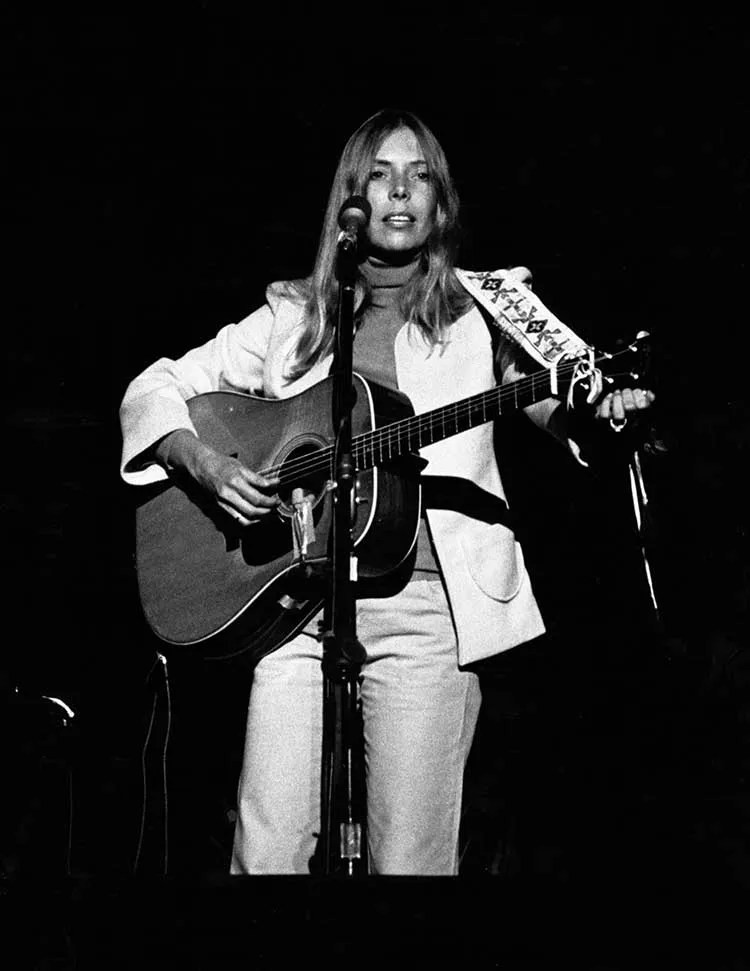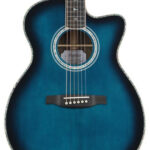Joni Mitchell’s music is instantly recognizable for its captivating melodies and harmonies that consistently defy expectations. A core element of her groundbreaking sound is H.e.r Guitar, a sonic entity unlike any other. It’s not simply an accompaniment; it’s a voice in itself. The treble strings shimmer like a cool jazz horn section, the bass snaps with syncopated rhythms reminiscent of a snare drum, and chords resonate in ways that seem impossible on a standard six-string. Combined with her distinctive voice, which expands upon the harmonic textures and enriches the melody with both raw storytelling and evocative poetry, h.e.r guitar becomes an integral part of her innovative musical landscape.
Despite her status as a revered songwriter and a profound influence on generations of musicians, the methods and inspirations behind Mitchell’s unique guitar work have remained largely enigmatic. For guitarists captivated by her playing on albums such as Court and Spark or Hejira, seeking to emulate that sound in a music store proves a fruitless endeavor. Her approach, from her distinctive tunings to her right-hand technique, exists outside the conventional realm of guitar playing. The only readily available resource documenting her extensive guitar journey is a collection of four songbooks transcribed by Joel Bernstein, her longtime guitar technician and archivist. These transcriptions offer a glimpse into her tunings and chord shapes, but represent a small fraction of a 17-album career, each album marking a significant departure from its predecessor. Remarkably, Mitchell herself relies on Bernstein’s deep understanding of her own catalog. Having continuously explored new tunings and rarely revisiting older material, Bernstein has often been instrumental in helping her relearn some of her earlier songs.
Following her 1996 Grammy win for Best Pop Album for Turbulent Indigo, an album that marked the powerful return of her acoustic guitar to the forefront, Joni Mitchell offered a rare and insightful look into her guitar playing and compositional process in an interview.
“There’s a certain kind of restlessness that not many artists are cursed or blessed with, depending on how you look at it,” Mitchell explained. “Craving change, craving growth, seeing always room for improvement in your work.” This statement encapsulates the essence of her musical philosophy: viewing music as a perpetual process of invention, rather than a series of fixed works.
Joni Mitchell’s initial steps with the guitar mirrored those of many aspiring musicians in the 1960s, but she quickly diverged onto a less-conventional path. “When I was learning to play guitar, I got Pete Seeger’s The Folksinger’s Guitar Guide,” she recalled. “I went straight to the Cotten picking. Your thumb went from [imitates alternating-bass sound] the sixth string, fifth string, sixth string, fifth string… I couldn’t do that, so I ended up playing mostly the sixth string, but banging it into the fifth string. So Elizabeth Cotten definitely is an influence; it’s me not being able to play like her. If I could have I would have, but it’s a good thing I couldn’t, because it came out original.” This early deviation, born from a technical limitation, became the seed of her distinctive approach to h.e.r guitar.
 Joni Mitchell onstage with acoustic guitar
Joni Mitchell onstage with acoustic guitar
Alongside her departure from standard folk fingerpicking techniques, Mitchell also broke away from standard guitar tuning. Remarkably, only two of her songs, “Tin Angel” and “Urge for Going,” are in standard tuning. “In the beginning, I built the repertoire of the open major tunings that the old blues guys came up with,” she stated. “It was only three or four. The simplest one is D modal [D A D G B D]; Neil Young uses that a lot. And then open G [D G D G B D], with the fifth string removed, which is all Keith Richards plays in. And open D [D A D F# A D]. Then going between them I started to get more ‘modern’ chords, for lack of a better word.” As she began composing in the mid-1960s, these tunings became intrinsically linked to her songwriting, shaping the very DNA of h.e.r guitar sound.
Mitchell’s first three albums, Joni Mitchell (1968), Clouds (1969), and Ladies of the Canyon (1970), showcase a blend of traditional open tunings and more exploratory sonic territories. Tracks like “Both Sides, Now” (capo II) and “Big Yellow Taxi” are in open E (E B E G# B E—identical to open D but a whole step higher), while “The Circle Game” (capo IV) and “Marcie” are in open G. However, it was the more adventurous tunings, such as C G D F C E for “Sisotowbell Lane,” with its intricate chords achievable through simple fingerings, that truly captivated her. These tunings became the bedrock of her music from the early 1970s onwards, defining the evolving voice of h.e.r guitar.
“Pure majors are like major colors; they evoke pure well-being,” she explained, reflecting on her harmonic choices. “Anybody’s life at this time has pure majors in it, given, but there’s an element of tragedy. No matter what your disposition is, we are air breathers, and the rain forests coming down at the rate they are… there’s just so much insanity afoot. We live in a dissonant world. Hawaiian [music], in the pure major—in paradise, that makes sense. But it doesn’t make sense to make music in such a dissonant world that does not contain some dissonances.” This philosophical approach to harmony reveals a depth to h.e.r guitar beyond mere technicality; it’s a reflection of the world around her.
The term dissonances might suggest harsh or jarring sounds, but the “modern chords” Mitchell discovered in alternate tunings possess a remarkable softness. Consonance and dissonance interplay subtly, creating a unique harmonic texture. While categorizing these sounds is challenging, Mitchell is adamant about one thing: they are far removed from folk music. “It’s closer to Debussy and to classical composition, and it has its own harmonic movement which doesn’t belong to any camp,” she asserted. “It’s not jazz, like people like to think. It has in common with jazz that the harmony is very wide, but there are laws to jazz chordal movement, and this is outside those laws for the most part.” This distinction underscores the originality of h.e.r guitar, placing it in a genre of its own making.
So, how does Mitchell uncover the tunings and fingerings that give rise to these expansive harmonies? She described her process: “You’re twiddling and you find the tuning. Now the left hand has to learn where the chords are, because it’s a whole new ballpark, right? So you’re groping around, looking for where the chords are, using very simple shapes. Put it in a tuning and you’ve got four chords immediately—open, barre five, barre seven, and you higher octave, like half fingering on the 12th. Then you’ve got to find where the interesting colors are—that’s the exciting part.” This “twiddling” and exploration are central to the spontaneous and inventive nature of h.e.r guitar.
“Sometimes I’ll tune to some piece of music and find [an open tuning] that way, sometimes I just find one going from one to another, and sometimes I’ll tune to the environment. Like ‘The Magdalene Laundries’ [from Turbulent Indigo; the tuning is B F# B E A E]: I tuned to the day in a certain place, taking the pitch of birdsongs and the general frequency sitting on a rock in that landscape.” This intimate connection to her surroundings, translated into guitar tunings, illustrates the deeply personal and organic nature of h.e.r guitar.
Mitchell likens her constant exploration of tunings to using a typewriter where the letter keys are rearranged daily. Mistakes are inevitable, but these very errors become the catalyst for discovery. “If you’re only working off what you know, then you can’t grow,” she explained. “It’s only through error that discovery is made, and in order to discover you have to set up some sort of situation with a random element—a strange attractor, using contemporary physics terms. The more I can surprise myself, the more I’ll stay in this business, and the twiddling of the notes is one way to keep the pilgrimage going. You’re constantly pulling the rug out from under yourself, so you don’t get a chance to settle into any kind of formula.” This philosophy of embracing the unexpected is fundamental to the continuous evolution of h.e.r guitar.
To date, Mitchell estimates she has used 51 different tunings. This extraordinary number is partly due to the gradual lowering of her tunings over the years, resulting in some tunings recurring at different pitches. Generally, her tunings began around open E and progressively dropped to D, then C, and in recent times, even to B or A in the bass. This evolution mirrors the gradual deepening of her voice since the 1960s, likely a result of smoking. The physical changes in her voice have directly shaped the sonic landscape of h.e.r guitar.
When performing older songs today, Mitchell typically uses a lower-pitched version of the original tuning. “Big Yellow Taxi,” originally in open E, is now played in a low open C tuning (C G C E G C, equivalent to open E dropped two whole steps). “Cherokee Louise,” recorded on Night Ride Home in D A E F# A D, was performed on Canadian TV show Much Music in C G D E G C—a whole step lower. This C tuning, also used for “Night Ride Home,” is reportedly her current favorite, according to Joel Bernstein. These adaptations demonstrate the fluidity and adaptability of h.e.r guitar across her career.
In some instances, similar relative tunings reappear at different registers for different songs. “Cool Water” (Chalk Mark in a Rain Storm) and “Slouching towards Bethlehem” (Night Ride Home) share the tuning D A E G A D. A half step lower, C# G# D# F# G# C#, is the tuning for “My Secret Place” (Chalk Mark), and a whole step below that, B F# C# E F# B, is the tuning for “Hejira.” These connections allow Mitchell to transfer fingerings between tunings, creating a sense of consistency within her ever-changing sonic world, yet each tuning still retains its unique sonic identity within the broader spectrum of h.e.r guitar.
“You never really can begin to learn the neck like a standard player, linearly and orderly,” she observed. “You have to think in a different way, in moving blocks. Within the context of moving blocks, there are certain things that you’ll try from tuning to tuning that will apply.” This “moving blocks” approach to the fretboard is a direct consequence of her tuning explorations, forcing a departure from conventional guitar learning and fostering a more intuitive, shape-based understanding of h.e.r guitar.
 folk, bluegrass, country lessons from acoustic guitar magazine
folk, bluegrass, country lessons from acoustic guitar magazine
While an interesting tuning can be a fertile starting point for songwriting, as evidenced by countless new-age guitar albums, it’s the player’s interaction with the tuning, their technique and compositional sensibility that truly matter. Throughout her music, Mitchell masterfully utilizes the freedom offered by open tunings to navigate the guitar neck. A signature element of her style is the juxtaposition of notes fretted high on the neck against resonant open strings. This technique expands the accompaniment’s range, as heard in songs like “Chelsea Morning” (Clouds, open E), where a high riff on the top two strings dances above the open bass strings, followed by a fretted bass line moving below the open treble strings. This interplay of registers is a hallmark of h.e.r guitar.
In Mitchell’s later songs, characterized by more radical tunings, the ringing open strings take on a different quality, functioning as a drone, a harmonic thread connecting chords. “It’s like a wash,” she explained, drawing a parallel to painting. “In painting, if I start a canvas now, to get rid of the vertigo of the blank page, I cover the whole thing in olive green, then start working the color into it. So every color is permeated with that green. It doesn’t really green the colors out but it antiques them, burnishes them. The drones kind of burnish the chord in the same way. That color remains as a wash. These other colors then drop in, but always against that wash.” This “wash” of drone strings adds depth and texture to the harmonic palette of h.e.r guitar, creating a rich and immersive sonic experience.
Upper melodies, moving bass lines, drone strings—all these facets of Mitchell’s guitar style originate from her conception of the guitar as a multi-voiced instrument. “When I’m playing the guitar,” she stated, “I hear it as an orchestra: the top three strings being my horn section, the bottom three being cello, viola, and bass—the bass being indicated but not rooted.” This orchestral vision encapsulates the essence of h.e.r guitar: a singular instrument capable of producing a rich tapestry of sounds, defying convention and continuously evolving, solidifying Joni Mitchell’s place as a true guitar innovator.

